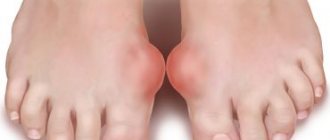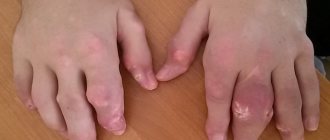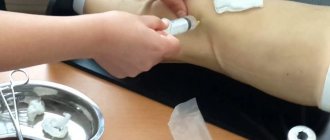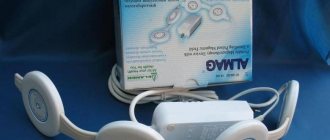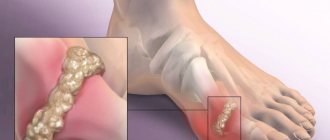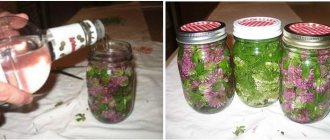Gout
Gout is a disease consisting of a disorder of uric acid metabolism. Gout is usually classified as a joint disease because excess uric acid forms salts (urates), which are deposited primarily in the joints. The first joint affected is the joint of the big toe. An inflamed bump on the thumb is a characteristic symptom of gout.
Genetically, men are more predisposed to this disease. Among the sick, almost 95% of them are. The peak incidence in men occurs at the age of 40-50 years, in women – from 60 years and older. However, gout can also affect people at a younger age.
Causes of gout
Any product of biological origin contains purines - substances that are building materials for RNA and DNA. Purine bases ingested in food are broken down, resulting in the formation of uric acid. This is a normal process. Uric acid is present in body tissues and blood plasma. The blood carries uric acid to the kidneys, where it is filtered and excreted in urine. Part of the uric acid (1/3) is excreted through the intestines. If this normal metabolism is disrupted, uric acid begins to accumulate in excess amounts.
Violations of purine metabolism can be caused by:
- genetically determined fermentopathy
. Gout develops if the production of enzymes responsible for converting purine bases into uric acid and removing the latter from the body deviates from the norm (deficiency of some enzymes is critical, hyperfunction of others). This disorder is largely due to DNA damage. The site responsible for these enzymes is located on the X chromosome. Men have one X chromosome, and women have two. This is why men are more likely to suffer from gout (women have, so to speak, a “backup copy” of the necessary genes);
- increased consumption of purine bases
. In ancient times, gout was called the “disease of kings.” The kings ate the best food, and could eat the meat of young animals, deli meats and cream pies unlimitedly (and these products are leaders in purine content. There are also a lot of purines in fatty fish, meat and fish broths, and legumes). In itself, an excess of purines in food is not dangerous, since normally the kidneys cope with the entire volume of uric acid produced. However, if there is a genetic pathology or kidney problems, gout becomes very likely;
- violation of the excretion of uric acid from the body
. If you have kidney disease, uric acid filtration may decrease. Less of it will be excreted, and its concentration in the blood will increase;
- increased catabolism of the body's own purine compounds
. Man is part of the biological world, and our body is built according to general laws. RNA and DNA are present in our body - in every cell, which means they have their own purine bases. Increased cell destruction (or otherwise catabolism - the breakdown of complex compounds into simpler ones) leads to the same increase in uric acid in the blood as if we began to receive an excess amount of purines from the outside. The reasons for the increased catabolism of purine compounds in one's own body may be radiotherapy or chemotherapy, taking certain medications, hemolysis (decomposition of red blood cells, which is caused by severe infectious diseases or diseases of the hematopoietic system).
2. Reasons
Uric acid is one of the bioactive substances necessary for the body; in water it dissolves slightly and is broken down by special enzymes, and in the blood it is present in the form of salts (urates). Urate crystals, accumulating in the joints, lead to the development of gouty arthritis, the second most common joint disease after rheumatic arthritis. An increase in the concentration of uric acid compounds may be due to a congenital deficiency of the enzymes that break it down (for the production of which the “male” X chromosome is responsible, which explains gender differences in morbidity). Statistical correlations of gout with hypertension, alcoholism, congenital abnormalities of the structure and functioning of the renal tubules, certain types of cancer pathology, obesity and other factors have also been identified and confirmed.
Visit our Thoracic Surgery page
Gout symptoms
An attack of gout is manifested by acute pain in the affected joint
The first stage of gout is described as hyperuricemia (increased uric acid in the blood). Hyperuricemia is detected using a biochemical blood test. In most cases, no other symptoms of the disease are detected. Sometimes general weakness, sweating, itchy skin, and constipation may occur.
Actually, it is worth talking about gout from the moment of the onset of acute gout attacks. An attack of gouty arthritis can be triggered by:
- drinking alcohol (single consumption of a significant dose);
- hypothermia;
- joint injury;
- common acute respiratory infections.
First of all, as a rule, the joint of the big toe (first metatarsophalangeal joint) is affected. Typically the joint is affected in only one leg. Quite often other small joints are affected - the wrist or phalanges of the fingers. In the future, other joints may suffer from gout attacks. In women, the disease can affect several joints at once at the very beginning.
Typically, an attack of gouty arthritis lasts no more than 5-7 days, after which complete remission occurs (all symptoms disappear) - until the next attack. This course of gout is called the intermittent (“interval”) stage. Then the disease can progress to the chronic stage.
Attack of gouty arthritis
An attack of gouty arthritis is manifested by acute pain in the joint. Quite quickly, the area of the affected joint swells and turns red. The color of the skin over the joint may take on a bluish tint. The patient feels chills and the temperature rises, possibly up to 38 °C or higher. Any touch to the joint increases the pain, the joint completely loses mobility. The pain can be very intense and cannot be relieved by analgesics.
In most cases, the attack occurs at night; by morning the pain usually subsides. However, in severe cases, severe pain can last up to 3 days, then its intensity slowly decreases.
Chronic gout
If attacks of gouty arthritis become frequent and are quite severe (periods of pain prevail over periods of remission), chronic gout is diagnosed. The chronic form of the disease is characterized by increased dysfunction of the affected joints, and as the patient stops using them, atrophy of the articular muscles develops.
A specific symptom of gout is the formation of tophi. Tophus is a subcutaneous or intradermal accumulation of urates (uric acid salts). Tophi look like nodules - dense, rounded formations. Their diameter can vary from 2 mm to 5 cm or more. Tophi usually appear approximately 5 years after the first attack of gout, slowly increasing in size. However, with an unfavorable course, their formation can occur more quickly. Typical places where they occur are fingers and toes, ears, knee and elbow joints, feet, and brow ridges. It doesn't hurt to touch these formations. The skin over tophi is usually dry and rough because its blood supply is impaired. Over time, a fistula may form in this place, through which a white pasty mass (urate itself) is released.
Tophi are not always formed (only in 50-60% of patients).
Chronic gout also often causes urolithiasis. Urates can form kidney stones, which can cause renal colic, block the outflow of urine, and contribute to the development of pyelonephritis.
Methods for diagnosing gout
Diagnosis of gout includes physical, laboratory and instrumental research methods. The diagnosis of gout is made when several signs characteristic of this disease coincide
Physical diagnosis
Physical diagnosis involves visual examination of the patient and palpation. The examination results are compared with the patient’s complaints and medical history.
Laboratory diagnostics
Laboratory diagnostics make it possible to establish that the cause of pathological changes in the joint is a violation of uric acid metabolism. The following analyzes play a decisive role in this:
- biochemical blood test (the level of uric acid in the blood plasma is important);
- analysis of synovial (intraarticular) fluid for the presence of urates in it. To do this, a puncture of the joint is done.
- 24-hour urine collection can be performed to assess glomerular filtration rate.
If there is a need to confirm that the detected tumors in the joint are tophi, a biopsy is performed with further examination of their contents.
Instrumental diagnostics
X-rays can reveal pathological changes in the joints. They occur in late stages, so the onset of the disease cannot be determined using x-ray methods. To identify tophi (they do not always protrude above the surface of the skin), computed tomography or MRI are used.
In the early stages, ultrasound can be used. Using ultrasound, fairly small deposits of salts are detected, so tophi are visible on ultrasound even at the stage of their formation. Also a characteristic sign of gout is a “double contour” - the appearance of an echogenic strip running parallel to the line of the articular cartilage. It occurs because salt crystals do not penetrate the structure of the cartilage, but simply cover it on top, creating a duplicate contour that is clearly visible during examination.
Sign up for diagnostics To accurately diagnose the disease, make an appointment with specialists from the Family Doctor network.
Treatment methods for gout
Treatment for gout is aimed at:
- in case of an acute attack - to relieve it;
- in the remission stage - to normalize uric acid metabolism. Of course, one should strive to eliminate the cause of the disease. However, if the cause of gout is fermentopathy, this is impossible. In this case, treatment will be symptomatic.
- for the treatment of concomitant diseases.
A complete cure for gout is impossible. However, with medical help, it is possible to reduce the frequency of attacks and achieve a significant increase in periods of remission.
4.Treatment
Therapy for urate nephropathy is always complex. It is necessary to control and relieve exacerbations of gout as the underlying disease, treatment and prevention of hypertension, and normalization of body weight. A diet is strictly required, which the doctor develops and explains on an individual basis (however, in any case, beer, certain types of fish and a number of other products that promote the production of uric acid are excluded). Sugar consumption is also sharply reduced, since there is a direct connection between the incidence of gout and diabetes. Diuretics (diuretics) and urostatics are prescribed - drugs that suppress the secretion of uric acid. Regular observation by a doctor of the appropriate profile and monitoring of laboratory tests are mandatory.
The prognosis is generally favorable, provided that all medical prescriptions are followed, especially those related to lifestyle and bad habits. In recent decades, significant advances have been made in understanding the etiopathogenesis and, accordingly, developing strategies for effective therapeutic control of renal (renal) functions in urate nephropathy.
Which doctor treats gout?
For treatment of gout, you should consult a rheumatologist. The help of an orthopedic doctor may be required (for example, if surgery is necessary).
Treatment of an acute attack
First of all, the patient needs rest. The inflamed joint should be immobilized. It is recommended to apply cold. You need to drink plenty of alkaline fluids - up to 3 liters per day. It is important to follow a diet: foods high in purine bases should be excluded. Painkillers (NSAIDs) and glucocorticoids are used as prescribed by a doctor. Local treatment is carried out using ointments and gels that have anti-inflammatory and analgesic effects.
When the patient feels better, physical therapy is included in the treatment. Electrophoresis, UV irradiation, and UHF are used.
Treatment of gout in remission
Treatment in remission includes:
- lifestyle changes (primarily giving up alcohol);
- diet (exclude foods that contain a lot of purines - fish, mushrooms, legumes). The diet must be prescribed by a doctor;
- drug therapy (anti-gout drugs);
- local treatment - applications of medications, physiotherapy, massage, medicinal baths (in sanatoriums);
- surgical treatment: removal of tophi that are not amenable to conservative treatment, surgical restoration of affected joints.
Make an appointment Do not self-medicate. Contact our specialists who will correctly diagnose and prescribe treatment.
Rate how useful the material was
thank you for rating
Gouty nephropathy (Uric acid nephropathy, Urate nephropathy)
The main therapeutic goals are to reduce the synthesis of uric acid, nephroprotection, improve renal microcirculation, and slow down progressive nephrosclerosis. Drug treatment must be supplemented with correction of physical activity, drinking regimen and diet. Patients with gouty kidney damage are advised to eat minimally calorie, low-protein diets, frequent alkaline drinks, and moderate physical activity for weight loss. When choosing drugs for the treatment of uric acid nephropathy, the form and stage of the disease are taken into account.
The management of patients with acute urate nephropathy is similar to the treatment of acute renal failure. In case of patency of the ureters and the absence of anuria, continuous infusion therapy is indicated under the control of diuresis with the introduction of monosaccharides, polyhydric alcohols, physiological or polyionic crystalloid solutions, and loop diuretics. At the same time, pain relief with tropolone alkaloids is prescribed, and xanthine oxidase inhibitors are used. The ineffectiveness of intensive conservative treatment carried out within 60 hours is an indication for transferring the patient to hemodialysis.
Patients with chronic gouty kidney undergo therapy to correct the concentration of uric acid and prevent the development of possible complications. When selecting a drug, be sure to take into account the stage of the pathological process and the preservation of the filtering function. Most often used to treat uric acid nephropathy:
- Uricodepressive drugs
. Inhibitors of xanthine oxidase, glutamine phosphoribosyltransferase and, to a lesser extent, carbon conjugators of phosphoribosyl pyrophosphate affect xanthine metabolism and disrupt the synthesis of uric acid. By effectively reducing hyperuricemia, they reduce the severity of uricosuria, and therefore the risk of stone formation. They have a moderate nephroprotective effect: they reduce the severity of proteinuria, renin synthesis, the production of free radicals, slow down glomerulosclerosis and nephroangiosclerosis. Not recommended in the presence of chronic renal failure. - Uricosuric drugs
. By inhibiting the reabsorption of urates, they increase the excretion of uric acid, but increase the load on the kidneys. Indicated when hyperuricemia is combined with a normal content of uric acid salts in the urine, the absence of stones and preserved filtering function. Taking into account individual sensitivity and possible contraindications, patients with gouty kidney are prescribed derivatives and analogues of sulfinpyrazone, zinchofen, probenecid, 5-chlorobenzoxazole, and cabuzone. Some of these drugs have a moderate diuretic effect.
In the presence of urolithiasis, uric-destroying agents based on lithium salts, piperazine, the enzyme urate oxidase, and citrate mixtures are used to dissolve urate stones. An effective combination of basic anti-gout drugs with phytouroantiseptics that prevent pyelonephritis, physiotherapeutic techniques (phototherapy, magnetotherapy, electric pulse therapy), and sanatorium-resort treatment.
As chronic renal failure increases, renal replacement therapy is performed (hemodialysis, peritoneal dialysis, hemofiltration, hemodiafiltration). For patients with large stones that interfere with the passage of urine and irritate the parenchyma, nephrolithotomy, pyelolithotomy, percutaneous or remote nephrolithotripsy are indicated.
